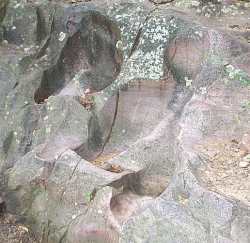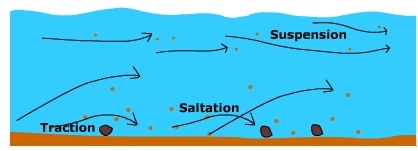Geologic Work of StreamsWater flowing through a stream performs three kinds of geologic work. Moving water erodes material from the bed and sides of the channel, it transports the eroded material to a new location, and then deposits it. Material deposited by streams is called alluvium. The ability of a stream to do work is a function of stream velocity and discharge. ErosionStream erosion is the detachment of material from the bed
or sides of the channel. Approximately 95% of a stream's energy is used to
overcome frictional effects imposed by the channel and internal molecular
friction. This leaves only 5% of the stream's energy for
vertical and lateral cutting. Flowing water erodes in three ways. First,
flowing water dissolves materials from the channel contributing to
stream's dissolved or, solution load. Secondly, the impact of
water, or hydraulic acti Figure 18.27 Potholes created by scouring bedrock, Devil's Lake, WI.(Courtesy M.Ritter) TransportationOnce material is detached from the channel it can be transported. Transportation is the movement of earth material, in this case, by water. As particle size increases, so too does the velocity needed to transport it. The material transported through the stream is it's stream load. Stream load is composed of dissolved or solution load, suspended load, and bed load. The dissolved load comes primarily from groundwater seepage into the stream. Ions in solution also come from the solution of materials that line the channel. Suspended load is comprised of sediment suspended and transported through the stream. Turbulent flow suspends clay and silt in the stream. Suspended load comes from material eroded from the surface bordering the channel and deposited in the stream, as well as, erosion of the channel itself. Figure 18.28 Stream Load The stream capacity is the maximum load of sediment a stream can carry for a given discharge. As one might expect, stream capacity increases with increasing flow velocity. Increased water velocity imparts a greater frictional drag on bed to erode it. Turbulent flow occurs under higher velocity thus increasing the water's ability to dislodge material from the bed or sides of the stream. Stream competence is the largest size material the stream can move under a given discharge. Bed load is that which is moved across the bed of the channel. Bed load is transported in two ways, traction, which is a scooting and rolling of particles along the bed. The second is saltation, a bouncing-like movement. Saltation occurs when particles are suspended in the stream for a short distance after which they fall to the bed, dislodging particles from the bed. The dislodged particles move downstream a short distance where they fall to the bed, again dislodging particles upon impact. Figure 8.29 Bedload Transport of the Kootenai River, ID (Courtesy USGS. Source) DepositionAs velocity and discharge decreases, the ability of the stream to move sediment through it decreases. The heaviest particles deposit on the bed first, with the smaller and lighter particles transported much further before accumulating. Aggradation raises the elevation of the bed by the accumulation of sediment in the channel. Deposits of sand and gravel as bars can separate the channel into numerous smaller channels resulting in a braided channel.
Figure 8.* Watch "Stream Aggradation." |


